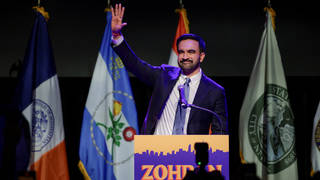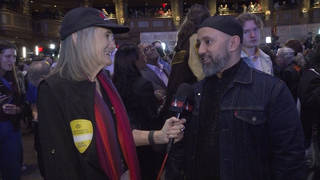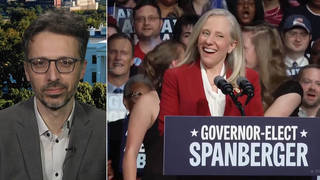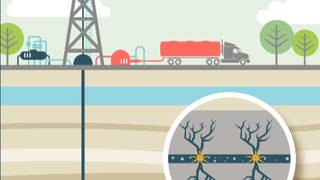
Guests
- Sandra Steingraberactivist and biologist. She co-founded both New Yorkers Against Fracking and Concerned Health Professionals of New York. She is the author of Living Downstream and Raising Elijah: Protecting Children in an Age of Environmental Crisis.
- Tony Ingraffeaprofessor emeritus and Weiss Presidential Teaching Fellow at Cornell University. He is also the president of Physicians, Scientists and Engineers for Healthy Energy, Inc.
New York has become the first state in the nation with major natural gas deposits to ban the oil and gas extraction process of hydraulic fracturing, known as fracking, citing potential risks to public health. Fracking involves blasting sand, water and toxic chemicals deep into shale rock to release oil and gas, a process which can poison water supplies and pollute the air. Following a two-year study, New York Acting Health Commissioner Howard Zucker said fracking was too risky. We speak to biologist, activist and author Sandra Steingraber, co-founder of New Yorkers Against Fracking. Also joining us is Cornell University professor Tony Ingraffea, president of Physicians, Scientists and Engineers for Healthy Energy.
Transcript
JUAN GONZÁLEZ: New York has become the first state in the nation with major natural gas deposits to ban the oil and gas drilling process known as fracking, citing potential risks to public health. Fracking involves blasting sand, water and toxic chemicals deep into shale rock to release oil and gas, a process which can poison water supplies and pollute the air. Following a two-year study, acting New York Health Commissioner Howard Zucker said fracking was too risky.
HOWARD ZUCKER: The potential risks are too great. In fact, they are not even fully known. Relying upon the limited data that is presently available to answer the public health risks would be negligent on my part. I have identified significant public health risks in the current data. And until the public health red flags are answered by valid evidence through longitudinal long-term studies, prospective analysis, patient surveys with large population pools showing that the risk for impact on public health are avoidable or sufficiently low, I cannot support high-volume hydraulic fracturing in the great state of New York.
AMY GOODMAN: The decision to ban fracking was announced by New York Governor Andrew Cuomo.
GOV. ANDREW CUOMO: This is an emotional debate, and I think this is a very factual presentation and persuasive on the facts. Do I believe the facts will trump all emotion? No. So I’m sure the people who disagree with this will continue to disagree with it.
JUAN GONZÁLEZ: Anti-fracking activists welcomed the ban with celebrations across the state. Environmentalists have waged a fierce campaign to ban fracking in New York. The actor and longtime anti-fracking activist Mark Ruffalo posted a short video online after the ban was announced.
MARK RUFFALO: New York state just passed a moratorium on hydrofracking. Thank you, Governor Cuomo, Joe Martens and Commissioner Zucker. And thanks to all the beautiful, dedicated people in the anti-fracking movement, who used science, their guts, their brains and their hearts to make this day a reality. Love you!
AMY GOODMAN: Activists note infrastructure related to fracking remains in place upstate New York. On Tuesday, 41 people were arrested for blocking the gates of a gas storage facility as part of a campaign against the Texas-based company Crestwood Midstream. The group, We Are Seneca Lake, has seen more than 130 arrests in a series of actions against the company’s plans to expand methane gas storage at a lake which provides drinking water to 100,000 people.
Among those at the protest was the biologist, the activist, the author, Sandra Steingraber. She joins us now from Ithaca, New York. She co-founded both New Yorkers Against Fracking and Concerned Health Professionals of New York. Her books include Living Downstream and, her latest, Raising Elijah: Protecting Children in an Age of Environmental Crisis.
Also joining us from Cornell University is Cornell professor Tony Ingraffea. He’s also the president of Physicians, Scientists and Engineers for Healthy Energy.
We welcome you both to Democracy Now! This is a major decision. New York has major gas deposits. Sandra Steingraber, can you talk about how this actually happened? Sure, the governor announced it, but what was the pressure brought on the governor?
SANDRA STEINGRABER: Well, that’s a tale that could be told as an opera, I think. So, we had the good fortune to have a moratorium in place by our previous governor, and I’ll let Tony tell some of the details of how that came to be. But because we had pushed the pause button, that gave those of us in the scientific community a chance to begin to really look at the data and the research and what it showed.
And we started off with only a handful of studies. There were only six studies on the health effects of fracking and the environmental impacts in 2008, for example, when we had the first moratorium declared. Now there are 414 studies and counting. And so, it was like we had pieces of a jigsaw puzzle, and when you only have a couple of pieces and you try to see what the picture is, it’s hard to see. But we saw troubling signs, but it was a little bit like trying to read the tea leaves. And then, as more data came in and more studies were done, and we talked to more scientists and we knew what the data looked like that was in the pipeline that was coming up to be published, we began to put more pieces of the jigsaw puzzle. And now we have 414 pieces assembled.
And even though there are still parts of the picture we can’t see very well, what’s obvious to us now is that fracking is not only harmful to our water supply and poisons our air and is beginning to actually show signs of and indicators of making people sick, but also that the problems associated with fracking are inherent to the engineering itself and cannot be mitigated in any regulatory framework. So we couldn’t see any signs that fracking had been done in a certain way, under certain rules that could govern the safety of it such that people wouldn’t be harmed.
And so, we—Tony and I, together—as well as a whole bunch of other scientists, we didn’t just take that information to our regulatory agencies—although we did that, too—because they actually seem sort of deaf to the science. We started early on taking it directly to the citizenry. So, this idea that sort of science and politics exist in two separate boxes, I don’t think so. I mean, objectivity is one thing, and we’re really objective as scientists, but science is not neutral, and it’s not a monk that should be sequestered away in a monastery. Science is like a gladiator that should be in the public arena. And so, we took—we spent, I don’t know, a couple years, every Friday night in a church basement somewhere, in a Rotary Club, in a public library, in a junior high school gymnasium, giving PowerPoint presentations with whatever data we had to groups of citizens in small towns all across the state. And so, that began then citizen organization. Local ban movements sprang up. And then, of course, at some point in 2011, 2012, we had so many different anti-fracking groups, that we united them then under the umbrella, my organization, New Yorkers Against Fracking. And then, Concerned Health Professionals of New York was the sort of science branch of that movement.
And at the same time, Tony’s shop, Physicians, Scientists and Engineers, a completely separate organization, we began to look at the same data sets—PSE from a statistical point of view, we did the qualitative analysis. We not only brought that out to the people in our compendiums and reports, we sent it to our Department of Health commissioners, first Dr. Shah, now Dr. Zucker. We sent it to the DEC. We sent it to the governor. So we were constantly bringing data forward to inform the political process.
JUAN GONZÁLEZ: Well, Sandra—
SANDRA STEINGRABER: So that was a big—
JUAN GONZÁLEZ: And, Sandra—
SANDRA STEINGRABER: That was a big part of it.
JUAN GONZÁLEZ: —on that whole issue—
SANDRA STEINGRABER: And then, of course, musicians and filmmakers all played their own role in captivating the citizenry and uniting us and making us feel like we were on a winning team.
JUAN GONZÁLEZ: Well, Sandra, on this whole issue of your outreach to citizen groups, I remember talking to Governor Cuomo a few weeks ago when he was at the Daily News Editorial Board and asking him specifically about the fracking issue, and it was clear that he was feeling enormous pressure. Clearly, the primary vote, where Zephyr Teachout won huge numbers of vote in the region targeted for fracking, he was aware that there was a major upsurge in the population of New York state that was opposed to fracking. And I have to think that that had some kind of impact on this final decision of his health commissioner. Clearly, the local municipalities were banning fracking in their own area. There were protests constantly where the governor went. So this was a—meanwhile, the rest of the country was increasingly turning to fracking, other states. So this is a really unusual situation, what’s happened here in New York state.
SANDRA STEINGRABER: It is. And I really just want to be really clear and thank the governor for listening to the science, because the part of the pressure he was feeling was the pressure of science, because we equipped the citizenry to bring the science, as citizens, to their government. And Governor Cuomo then, in the end, said he would let science make the decision. And he sure did. So, from my perspective as a scientist in the public interest, as somebody who’s spent a lot of years in public health, where I see decision makers and political leaders and elected officials not interested and turning away from the science, here’s a governor who embraced it and said no and stood up to the gas industry. So, all my gratitude to you today, Governor Cuomo.
ANTHONY INGRAFFEA: Amen.
AMY GOODMAN: I want to turn to a clip from Josh Fox’s 2013 documentary, Gasland Part II. In this clip, Lisa Parr of Wise County, Texas, explains how her family’s health deteriorated after natural gas drilling began around their home.
LISA PARR: My daughter looks up. Her rash is all over her face. She has a nosebleed. Bob has a nosebleed, burning throat, burning eyes. I had a rash. It covered my scalp. It went through my entire body, literally to the bottoms of my feet. My throat would start swelling. I started gasping for air. I started stuttering. I started stumbling. My face drew up on my left side like I had Bell palsy.
AMY GOODMAN: That’s a clip from Gasland Part II by Josh Fox. I bumped into Josh Fox, interestingly, in Lima, Peru, at the major People’s Climate March last week in the midst of the U.N. climate summit. And he is going to—he’s interviewing people right now in the Amazon as he links oil politics and gas politics around the world. But I wanted to turn to Tony Ingraffea, professor emeritus and Weiss Presidential Teaching Fellow at Cornell University, also president of Physicians, Scientists and Engineers for Healthy Energy, Inc. Not a lot of people around the country are having this kind of success in getting a ban on fracking. Professor Ingraffea, talk about the science you presented and what you were most concerned about. I mean, this ban is based on health concerns.
ANTHONY INGRAFFEA: Yes, but before I answer that question directly, I want to expand a little bit on what Dr. Steingraber said about how this whole process occurred. It’s a perfect example of democracy now. In 2008, where all the other states lying over shale deposits opened the barn doors and let dozens of operators in, absent the science, New York had a special law on the books—an Environmental Quality Review Act. And it took the effort of an individual citizen, Dr. Stan Scobie, to write a brief to Governor Paterson pointing out that that law had to come into effect if shale gas was to be exploited in New York state. That’s a perfect example of an individual citizen informing a governor.
Governor Paterson wisely took heed and said, “OK, let that law go out, go forward,” and that led to something called an environmental review, an environmental impact statement. That led to hundreds of thousands of individual comments, written by citizens all over New York state, that turned back two—not one, not—actually three at this point, three versions of that environmental impact statement. And as of today, we still do not have a viable, valid environmental impact statement for shale gas in New York state. That’s one of the reasons for Governor Cuomo’s decision this week. So there’s another example of democracy at work.
And as Dr. Steingraber just pointed out, while that was happening, hundreds of thousands of New Yorkers saying, “No, your science doesn’t look good to us,” the scientists were at work, going from those six papers in 2008 to over 400 today. And the second wise governor took office in 2010, Governor Cuomo, and realizing that the science was not yet ready, concluded obviously that you don’t establish an important energy policy absent good science, especially science having to do with human health. So he waited, wisely, for the science to catch up. And it almost has. The puzzle is almost complete. We now see what the impacts are, and Dr. Zucker pointed them out in his comments earlier this week.
So, the science that had to be done—now, to answer your question directly—was obvious. What effects, through air, through water, through ground movements, through climate change, through leaking wells, through sociological effects on communities, economic effects on communities, ecological effects on communities? What science do we know when shale gas comes to town? And we knew very little in 2008.
So, some of those studies pointed out that shale gas, unlike previous conventional gas developments, is extremely intense. We have to have many, many wells per square mile—eight, nine, 10 wells per square mile. That means entire regions would have to see tens of thousands of wells. The prospective was that upstate New York was going to be patterned, checkerboard pattern, a pad every mile in one direction, every two miles in another direction, as far as the eye could see. And that means that we increase the risk of all the bad things that can happen when you drill a hole in the ground and when you try to extract enormous amounts of natural gas. There can be leaks. There can be failures. There can be transportation problems. There can be pipeline problems, compressor station problems, processor unit problems, storage problems. All of these lead to potential contamination of water supplies, underground drinking water supplies for people in private water wells, which is quite prevalent in upstate New York, and air contamination.
We all breathe the same air. We’re all downstream, as Dr. Steingraber’s book points out. You can’t isolate shale gas from the people. It makes the people be part of the shale gas-industrial operation. And the people of New York state, using their democratic powers, informed the governors of New York state that they wanted the science to declare whether a policy allowing shale gas development in New York was appropriate—19.8 million people in the state—on the one hand, their health; on the other hand, the potential, and now unrealizable, wealth of a few hundred people and a few foreign corporations. I think the decision became very clear for Governor Cuomo this week.
JUAN GONZÁLEZ: Professor Ingraffea, why do you think that this kind of a democratic process has not taken place in other parts of the United States? And, of course, the shale gas industry has expanded worldwide now, seeking to drill in—all over the planet.
ANTHONY INGRAFFEA: That’s an excellent question, and it goes back to one of the things I said. It was a bit of luck and a bit of wisdom on the part of a former governor. The luck was that Cornell had a law on its books that other states, most other states, don’t. And that law very simply says, if a new industrial process seeks to establish itself in the state of New York and it hasn’t been here before, it has to show—it has to show that it does not have deleterious effects on the environment and human health.
And shale gas development, despite what the president of the American petroleum association says—American Petroleum Institute says, is a new process. Developing shale gas is not your grandmother’s and grandfather’s oil and gas well in Texas. It’s an entirely new process. It’s orders of magnitude large in scale. The number of wells, the time it takes to drill wells, the amount of fracking fluid that’s used to stimulate the wells, the amount of waste that’s produced, the amount of ancillary infrastructure, pipelines, compressor station, processing units—all of that makes it different.
So why is it that Colorado or Texas or Oklahoma or Arkansas or Illinois, North Carolina and Maryland, which have negligible shale gas resources, why are they going forward? Two reasons: They didn’t have that law on the books, or that law wasn’t enforced, and, two, they didn’t have the time to generate the kind of citizen impact and citizen input that we luckily had because of that wise decision in 2008 in New York state. But those states are going to catch up. New York state, this is a landmark. This is the wellspring. This is where it all begins for those other states to say, “Yeah, it looks like it’s going to happen in places like Illinois, North Carolina and Maryland, but it hasn’t happened yet, and we can still stop it.” And in places like Colorado and Texas and Oklahoma and Arkansas, where the deleterious effects that you’ve already discussed, we’ve already discussed here, are now becoming more and more apparent every day, the citizens are being involved. They are getting motivated. And what we did in New York state is going to be a tremendous impetus for them.
JUAN GONZÁLEZ: And do you think—what do you think about the plummeting price of oil on the world market? Is this having some kind of an impact on the full-court press that the oil and gas industry has been doing now for several years in terms of shale gas extraction?
ANTHONY INGRAFFEA: Absolutely. We’re talking about a very complex, global-scale industry. What does happen in Russia does affect what happens in Pennsylvania. So, the dropping prices for hydrocarbons, oil and natural gas, are having huge effects on the industry itself. We’re seeing a pullback in the number of wells being drilled. We’re seeing a pullback in capital flowing from Wall Street into the coffers of the oil and gas industry so that they can drill their wells and build their infrastructure.
But more importantly, I think, here, it gives the lie to the promise, the empty promise, that the industry gave to most other states, and tried to give to New York state, which is, “We’re going to—there will be gold-paved streets for you. Everybody is going to get rich.” It doesn’t work that way in extractive industries. It’s boom-bust. And guess what. It’s now bust.
It didn’t take long. The industry oversupplied. Too many companies trying to get in very, very quickly to make a quick profit, when prices for oil and gas were high. They’ve driven down prices because of oversupply. They’ve made this attempt to address that problem by proposing to build liquefied natural gas exporting facilities on all coasts of the United States—and Canada—to try to get “American-made” natural gas, our resource, exported into foreign markets.
So, the people of New York state and the people of other states are now trying—are beginning to realize that that was all a charade. It was all a big lie. It’s corporate profit making underneath an American flag.
AMY GOODMAN: Before we wrap up—
ANTHONY INGRAFFEA: So, is it our gas and our oil? No. Are we really decreasing the cost of energy for Americans? No. For gas right now, gasoline for your car right now, sure. But now what we’re doing is causing a decrease in the most important secondary aspect of this effort, which is to rapidly increase renewable energy supplies.
So, I’m trying to point out that this is a very complex issue involving geopolitics, involving the fight between traditional energy sources, renewable energy sources, different states’ approaches, the people’s common pocketbook—how much they’re paying for energy now versus how much they’re going to be paying for energy in the future, and are they going to go out and buy a Prius tomorrow, or are they going to go out and buy a Hummer?
AMY GOODMAN: I want to thank you both for being with us, Professor Tony Ingraffea, professor emeritus at Cornell University, president of Physicians, Scientists and Engineers for Healthy Energy, Inc., and Sandra Steingraber. Dr. Steingraber is an activist, biologist, author, co-founded both New Yorkers Against Fracking and Concerned Health Professionals of New York. She has quite a remarkable résumé. She has been named Woman of the Year by Ms. magazine, one of “25 visionaries who are changing the world” by Utne Reader, among many other things.
And end with the quote of Rebecca Solnit, who said, “The governor did it because he was pushed hard by activists. Look at the weather vanes, but respect the wind.”
This is Democracy Now!, democracynow.org, The War and Peace Report. When we come back, we’ll be joined by two leading attorneys to talk about the CIA Senate intelligence report and to talk about the latest complaint that’s been filed in Europe to try to try Bush administration officials for torture. Stay with us.












Media Options